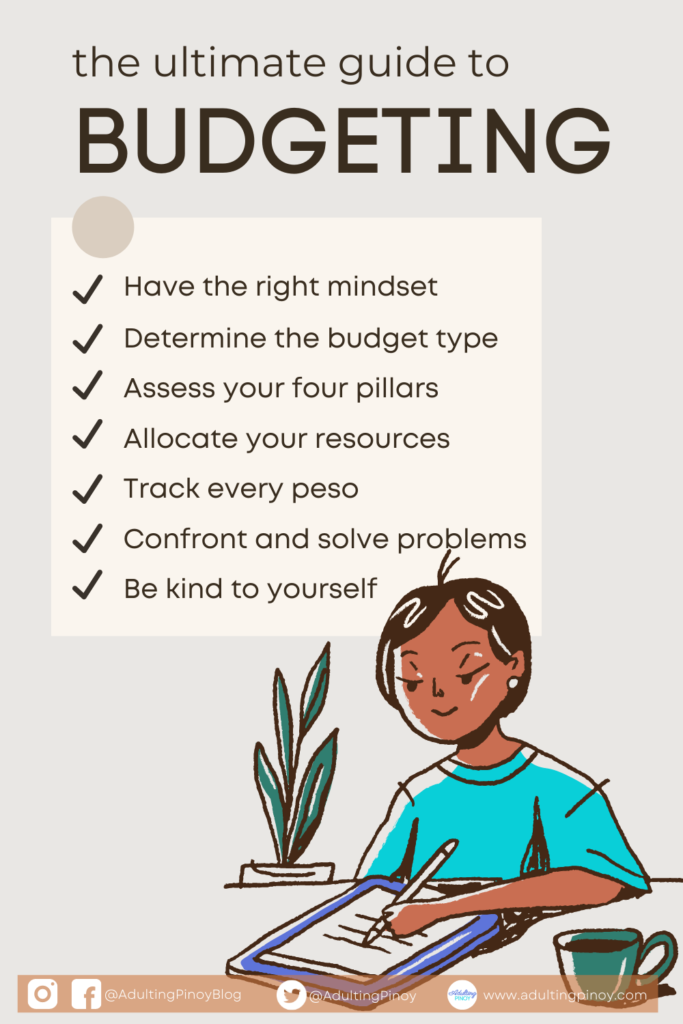Admit it: when you were a kid, you thought being an adult would be awesome. You would graduate, get a job, earn money, buy cool things for yourself — and that was it.

To your young mind, that was the definition of being an adult. Perhaps, that was even the extent of it.
But then, time goes by, and reality comes closing in. Until one day, you wake up and realize that adulting was nothing like you envisioned as a child.
If you’re lucky, you might get a job, and you might have money. But if you think about it, no one really taught us how to use it.
Although we know that budgeting is one of the most important things we have to do for financial success, it doesn’t come naturally to most of us. But don’t worry — that’s why we’re here.
In Adulting Pinoy’s ultimate guide to budgeting, we’ll discuss everything you need to know about this essential art.

Ready? Let’s go!
Budgeting Explained
Just hearing the word “budget“ brings to mind canceled plans and that pair of shoes that we can’t buy; because if we do, we’d be eating instant noodles for the whole month. It has an automatic negative connotation — because generally, people hate doing budgets. It feels restrictive. And it feels like if you have to do it, you’re already losing.
Contrary to widespread expectations, budgets aren’t there to ruin your fun. They’re there to make sure that you can have the best fun possible, by maximizing the resources you have available and by saving for the future.
A budget is a framework, a plan on how you will allocate your resources to extend it to the future or meet a goal. Every decision that you make following your budget gets you closer to this aim. Conversely, every decision you make which is not within your budget gets you further away.
Anything that you can spend money on, you can budget. And anything you can budget, you can control.
Step 0: Having the Right Mindset
Before everything else, we have to discuss having the right mindset for everything. And yes, we know that this is horribly cliche — but your mindset is everything, especially when it comes to budgeting.
Restricting your short-term reward in favor of long-term gain is not easy. Therefore, you need to have a strong and specific motivation to bolster this thought.
Notice; your motivation has to be strong and specific.
Consider this: you have 2 friends, both deciding they’re going to budget. You ask them why.
Friend 1 says, “I want to have a bit of extra money.”
Friend 2 says, “I don’t want to live paycheck to paycheck anymore, and I know that budgeting will help me make better decisions and avoid that feeling of helplessness at the end of the month. Also, I want to have some extra money in case of emergencies. With how things are going, it scares me that I would one day fall into a situation that would bury me in a debt that will take a lifetime to pay off.”
That took a dark turn, but well, we all have that friend. Who do you think would be more likely to succeed? We bet you picked friend 2. Why? Because their reasons were specific, driven, and practical.
If you want to succeed, have a decisive goal at the core of everything you do. The reasons could be compelling and passionate, just like friend 2, or they could be logical and SMART.
Before we get into the nuts and bolts, have a clear goal (or goals!) that you can strive towards.
6 Steps to Creating a Budget Plan
Have you made up your mind and formulated your why? Congratulations! You’re getting the hang of this adulting thing pretty well.

Now that you have the right mindset, we can proceed to discuss the hows. This section will tell you general guidelines on how you can establish a personalized budget plan.
Before we proceed, though, keep in mind that there are different strategies to budgeting for different kinds of personalities and temperaments.
There’s no one-size-fits-all formula when it comes to designing your life. This is why the following sections will give general principles of budget planning, not the specific formats that you should use.
1. Determine the Budget Type
There are many different types of budget schemes for individuals and businesses, but we don’t need to discuss them all here. In general, the kind of budget we are most likely to encounter as adulting Pinoys are these three: time-bound, item-based, and project-based budgets.
Time-bound Budgets
As the name suggests, this kind of budget relies on the passing of time to establish a spending routine.
If you have childhood memories of your parents telling you that the overpriced plastic toy you wanted to buy (for no reason at all) is ‘not in the budget,’ they were most likely referring to your month’s spending plan; a time-bound budget.
A monthly, weekly, or daily spending plan falls into this category. This type of budget guides how we spend our money over a particular period.
Item-based Budget
Have you ever set aside money for something that you wanted to buy? It could be as simple as a new pair of shoes or a new phone. It could be as grand as a personal vehicle, a plot of land, or even a home.
This is an item-based budget. In other words, the planning that you do to buy a specific thing. This type of budget isn’t necessarily time-bound — unless you’re after Shopee’s next sale, in which case it then becomes a project-based budget.
Project-based Budget
If you’re planning a fast project that you need to allocate money for, you’re creating a project-based budget.
In project management, a project is defined as a temporary effort with a clear starting and ending point, which creates a unique outcome.
The exact definition can be applied in our everyday lives. A project is something that we don’t regularly do and something with clear beginnings and outcomes.
For example, if you want to build your own cabinet, you need to determine what materials you need to buy and then see how much money you can allocate for that activity. The same goes for a trip with your friends or buying a home (sanaol).
This type of budget combines aspects of the item and time-bound budgets. You’re using the money to spend on something, but you only have a limited amount of time to do it. Thus, in project budgets, you’re more incentivized to seek other means of income or reduce expenses.
2. Assess Your Four Pillars
Your ‘financial pillars’ are the fundamentals of your money planning process; they’re the most essential things to consider. If you have these four things down pat, then you can proceed to fulfill any goal.

These are Assets, Income, Debts, and Expenses.
Assets
Your assets are a fancy way of calling resources that you already have.
Technically, your assets can mean anything that you can put a value on, from the clothes you wear on your back to the change rattling around in your wallet. But you’re not a multimillion-peso company (yet!); you’re a tough adulting Pinoy, so for now, let’s define your assets as the amount of money you have.
It’s essential to know how much money you currently have because it tells you where you are and how much more work you need. If your goals were like a road map, your current assets are the X with the mark ‘You Are Here.’
Income
This is the gross amount of money you have coming in. Whether this is your monthly allowance from your parents, your regular salary, or freelance work, any money that goes into your account is listed here.
Whereas your current assets determine where you are in your financial map, your income tells you how many strides you need to take to get to your endpoint.
As an example, if you have a significant income with little expenses, you’re going to need much less time to save your first 100k compared to a student who works part-time.
Debts
Filipinos have a surprisingly complex attitude about debt. Pe-Pua and Protacio-Marcelino (2000) documented that some core Filipino traits, such as ‘hiya’ and ‘utang na loob,’ affect how Filipinos handle money — because we seem to value personal relationships more than the money we lose or owe.
Thus, it’s perfectly understandable if you feel some sort of discomfort and anxiety in tallying your debts.
If you don’t have any significant debt, then good for you! However, this is a hard fact to face for most people. Whether it’s a loan from your parents and friends or a loan from the bank you’re in for the next half-century, you need to be painfully honest about whatever debt you have.
If your income is the strides you will take from your starting point to the goal, debts are the roadblocks that increase the overall distance between you and the finish line.
But don’t worry! There are strategies you can use to deal with debt, as well.
Expenses
Your expenses dictate how much you spend. Expenses exist for all types of budgets, whether you’re saving up for something (for a project or item budget) or whether it’s something that happens every month (monthly groceries, utility bills, commute, etc.).
Expenses can be further divided into two different categories: discretionary (wants) and non-discretionary (needs) expenses.
Just like debt, your expenses can serve as a further roadblock that increases the distance between your starting point and your end goal.
3. Allocate Your Resources
Now that we have a good measure of our starting point and a good idea of our income, debts, and expenses, we can decide how much money goes where.
For us, this is the most fun part of budgeting. There’s just something exciting about laying it all out — it makes you feel in control. Because you are. Although you can’t change everything (i.e., your rent), you’re still in control over a whole lot of things.
That’s why you must prioritize. Your money is limited, but your desires are not. See which expenses are absolute priorities, which would improve your life, and which would be merely nice to have.
Absolute Priorities
For example, you need to pay this month’s dues on your credit card debt, or you’re going to be in more trouble later on. That’s a need and must absolutely be prioritized.
The same goes for utility bills, like electricity, water, and the internet. Groceries and healthy food as well. Your absolute priorities must be the expenses that would immediately and drastically reduce your quality of life if not taken care of.
Life Upgrades

Life upgrades are not absolute needs but will immediately improve your quality of life, thus enabling better work.
For example, a good pair of shoes might not be on the same level as your credit card debt in terms of severity, but if you can afford to wear shiny new shoes during a job interview, then, by all means, do so.
The same principle applies to upgrades on your work-at-home station or a higher-quality mattress for your bedroom.
These expenses are not absolutely essential, and you will no doubt enjoy better work clothes or resting on a comfier bed at the end of the day. However, if you can afford it and pay it off, you will reap dividends from life upgrades.
Your Wants
Lastly, there are the things which would be nice to have, but which are neither essential nor will immediately improve your life. This is the category where most ‘wants’ fall under.
These things can be anything, from new clothes, unneeded appliance upgrades, and even to the 12th restaurant take-out you ordered this month. If it only gives you momentary satisfaction but doesn’t address a crucial need or improves your life, these are wants.
Take note; we’re not telling you to never reward yourself. However, rewards motivate you; they relax your body and mind to better take on challenges ahead. In short, rewards belong in the ‘life upgrades’ category.
On the other hand, wants are merely excessiveness. You can tell what a want is if your reasons for buying it are shallow, and you can get by without it.
4. Track Every Peso

You’ve probably heard the quote “what gets measured, gets managed,” and although it’s not applicable in all situations, it sure fits budgeting like those tight surgical gloves some of us unnecessarily wore during the start of quarantine.
Have you ever thought to yourself, “where did all my money go?”
Don’t answer that. We’re sure you have. This situation is the exact scenario we want to avoid by tracking where and how our money is spent.
There are many good reasons to track your expenses, but by far the most important one is that it gives you financial control. If you know where your money is going now, you can direct where it will go tomorrow.
So, how exactly should you track your money?
There are many ways available, from pen-and-paper to mobile apps. We’ve reviewed all of that—and more—in this article.
5. Confront and Solve Problems
Things definitely won’t go the way you want them to as you budget your money. There are going to be unexpected expenses, you’re going to forget to track your money, and you’ll lose sight of your goal. That much is to be expected.
That’s why the last step is to carefully monitor yourself and solve problems as they arise. Take stock, and then carefully think of how you might solve these problems.
For example, do you overspend on your groceries every month?
You might want to bring only your month’s budget to the grocery store the next time you shop, leaving everything else at home. This will force you to comply with your budget.
Do you get bored of budgeting every day, week, or month?
Get a physical reminder of why you did it in the first place. Post sticky notes on your computer monitor that contains how much you want to save that month and why. Maybe you want to buy a new laptop, phone, car, house?
Get pictures. Make it your phone’s wallpaper, so you see it every day. Constantly remind yourself of the strong and specific reason you formulated back in Step 0.
6. Be Kind to Yourself
Last but certainly not least is a reminder to be kind to yourself. As we’ve discussed in the section above, budgeting is a marathon, not a sprint. You’re in this for the long haul, and it won’t be an easy one.
You’ll face frustrations and challenges that will derail you from your plans, your goals might change midway, and you’re going to struggle with self-imposed limits.
When these things happen, it’s alright to let loose for a bit, and remember to be kind to yourself. Take a break from rigid planning, reward yourself with your favorite things, or take a little bit of your savings to spend on something that will make you happy. What matters is that you get back on your feet to try again.
Remember, no budget or financial goal is more important than your mental and emotional health.
Budgeting Strategies You Should Know
Now you have a firm foundation of what your budget plan should look like. You have a decisive goal; you’ve carefully assessed your current situation, allocated your resources, and tracked your money, and solved issues as they arrived.
Great! You now have the essentials. From there, you can form your own budgeting methods according to your needs and lifestyle.
Or you can follow these tried-and-tested budgeting strategies that people have been using for centuries.
Kakeibo: Japanese Household Financial Ledger

The kakeibo is a budgeting technique slash financial philosophy that journalist Hani Motoko first published in a women’s magazine in the early 1900s. The method has swept Japan since and has become a strong household practice.
The concept of kakeibo is simple and incorporates the principles we’ve discussed in this article. However, where kakeibo stands out is its emphasis on reflection and mindfulness, which you can achieve by physically writing down each day’s expenses in a financial journal—your kakeibo.
The 50/30/20 Rule
This budgeting ‘rule’ can be attributed to Senator Elizabeth Warren as she wrote in her book All Your Worth: The Ultimate Lifetime Money Plan.
This rule was made to be an easy-to-understand way for you to create a budget plan by dividing your after-tax income by 50%, 30%, and 20% allocations.
The most significant 50% should go into necessities, the 30% to your wants, and the last 20% to your savings or debt repayment.
The Envelope Method

The envelope method is another popular budgeting method that, albeit little is known where it comes from. This method involves putting physical cash on physical envelopes and then only using the money in that envelope in predetermined situations.
You can also apply the same principles using digital equivalents to separate your funds for different situations on different bank accounts.
The Ultimate Guide to Budgeting: Final Thoughts

Budgeting is a critical skill that won’t just build savings but also teach you a lot about yourself.
But it’s not an easy thing to do, and for most of us, it doesn’t come naturally in the slightest. To add to the complication, we all have different situations and things we’re dealing with.
That’s why this ultimate guide focused on touchstone principles that will guide you in creating your budget plan, not in making a specific kind of budget. We hope that the principles and concepts discussed in this guide will help you shape your budget plan and give you more control as you go about your adulting Pinoy life.
Did you like this article? Feel free to send us a message or leave a comment below!









